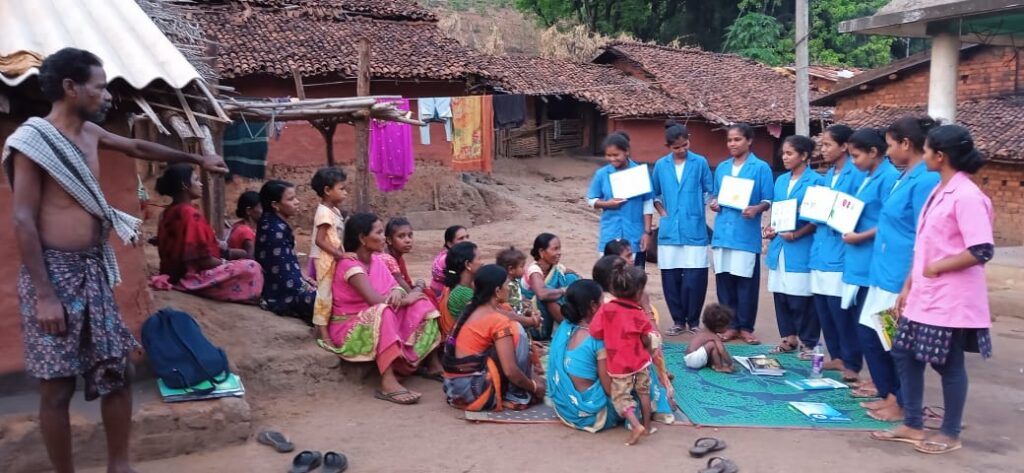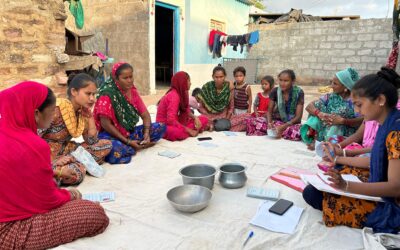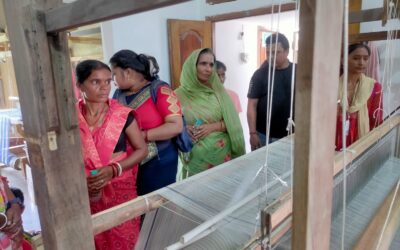Setting up non-formal education sessions for out-of-school adolescent girls is a critical aspect of the TULSI program, aimed at improving the health and nutrition of young girls under Swasthya Swaraj. Despite existing government schemes, accessing education remains a challenge for many girls. Non-Formal Education (NFE) serves as a crucial component, targeting school drop-outs and non-school going girls, with a goal to enhance basic literacy levels. This blog will explore the journey of implementing NFE classes, the challenges faced, and the observations made during the process.
The NFE Approach
Recognizing that many girls face economic hardships and family responsibilities, NFE classes are scheduled during evening hours. This allows the girls to participate in the sessions after their daily work, ensuring that education does not interfere with their livelihoods. Community members who cannot read or write are identified and trained as tutors for NFE classes. This not only ensures that the classes are led by familiar faces, but it also fosters a sense of ownership and commitment among the tutors. Having tutors from the community also facilitates better understanding of cultural nuances and language, making learning more relatable for the girls.
Before commencing the NFE classes, a pre-test is conducted. This is to assess the current literacy levels of the girls. This assessment helps in identifying areas of improvement and tailoring the curriculum accordingly. The initial module, ‘Know your Numbers’, targets numeric and basic arithmetic skills, building a foundation for future learning. It also relates to real-life scenarios, such as currency notes. In addition to basic literacy skills, the curriculum emphasizes life skills, health education, and nutrition. This holistic approach equips the girls with knowledge and abilities that contribute to their overall well-being and empowerment.
To keep the girls motivated and interested in the learning process, NFE classes use interactive teaching methods. The inclusion of multimedia tools like projectors to show songs and videos not only makes the sessions engaging but also enhances the girls’ understanding of the subjects. The progress of the girls is regularly monitored through periodic assessments and evaluations. This helps in measuring the impact of the NFE classes and making necessary improvements. We encourage girls to express themselves freely, ask questions, and seek clarifications without fear of judgment. The establishment of safe spaces enables a positive learning atmosphere, where girls can thrive and develop confidence.
Also read: What I Saw In Public Schools In Odisha
Key Observations
| 1. | Engaging Methods: Using projectors to show songs and videos sparked curiosity among the girls, enhancing their interest in the sessions. |
| 2. | Encouraging School Attendance: Identifying recent drop-outs, counsellors motivate girls to return to school, with support from other school-going peers. |
| 3. | Emotional Impact: Some girls who dropped out expressed emotional distress, highlighting the importance of providing educational opportunities. |
| 4. | Enhancing Visibility: Re-positioning projectors and arranging seating spaces improved student engagement and comfort during sessions |
| 5. | Community Support: Villagers’ interest in night classes highlights the demand for education; counseling parents is vital for ensuring regular school attendance. |
| 6. | Tutor Ownership: Tutors actively participate in sessions, seeking feedback and clarifying doubts, fostering a sense of responsibility among students. |

Challenges
- Hard-to-Reach Areas: Navigating difficult terrains poses challenges for conducting NFE sessions, requiring innovative solutions to ensure girls’ education reaches every corner.
- Dropout Rate: High dropout rates among adolescent girls due to early marriages, domestic responsibilities, or financial constraints. It needs tailored approaches to ensure consistent attendance.
- Socio-Cultural Norms: Deep-rooted cultural beliefs often discourage girls’ education, making it difficult to break down barriers and promote NFE classes.
- Lack of Infrastructure: Inadequate or non-existent educational infrastructure in some areas hampers the establishment of conducive learning environments.
- Limited Female Role Models: Absence of educated female role models in the community may limit girls’ aspirations for education and personal growth.
- Digital Divide: Lack of access to technology and internet connectivity hinders the integration of digital learning tools in NFE sessions.
Conclusion
Non-formal education is a crucial tool in empowering out-of-school adolescent girls. Despite multifaceted challenges, the dedication of tutors, support from the community, and the enthusiasm of the girls contribute to the success of the program. Bridging the education gap can pave the way for a brighter and more equitable future for these young girls. We are determined to continue this journey of transformation. By addressing these challenges proactively, we can build a more inclusive and empowering educational system for all.




It is a an acute problem here in Kutch as well. I think along with NFE, teaching a trade would also be helpful!